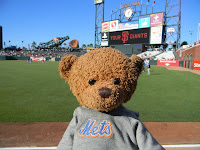Opposing Santana will be Jamie Moyer, the soon-to-be AARP member who is making a comeback with the Rockies after not having pitched in the major leagues since July 20, 2010 prior to this season. Moyer was originally drafted by the Chicago Cubs in 1984 and made his major league debut on June 16, 1986, or a time when the Mets still had only won one World Series championship.
So would you like to know more interesting things about Jamie Moyer, considering he's older than history itself? Here goes.
No, that's not Jamie Moyer in the photo above. We would never stoop so low to make that claim at his expense. That's actually his son, Jimmy Moyer, on the day his father signed his first pro contract.
Jamie Moyer won his major league debut for the Chicago Cubs on June 16, 1986, defeating the Phillies, 7-5. Who took the loss in that game? None other than Steve Carlton, a pitcher who was elected to the Hall of Fame in 1994 - 18 years ago!
The first time he faced the Mets, on July 29, 1986, Jamie Moyer got the win in a 2-1 Cubs victory. The only run scored by the Mets was driven in by George Foster. It was Foster's last RBI as a Met. A week later, Moyer faced the Mets again and got a no-decision in the Cubs' 8-5 victory, a game won on pinch-hitter Jerry Mumphrey's three-run homer. (Mumphrey has been out of baseball for 24 years now.) That loss would become Foster's last start as a Met.
Jamie Moyer has started 27 games against the Mets over his never-ending career, going 10-6 with a 3.94 ERA. The only National League team he has defeated more is the Florida/Miami Marlins, with 13 wins against them. The Marlins did not exist until Moyer's eighth season in the major leagues. By the time the Florida Marlins played their first game in 1993, Moyer had already pitched in 141 games (111 starts) for three teams (Cubs, Rangers, Cardinals) and had compiled a 34-54 won-loss record.
In 2007, when Tom Glavine was finished not being devastated over his one-third of an inning performance against the Florida Marlins in the Mets' season finale, it was Jamie Moyer who pitched the Phillies to victory and their first of five consecutive division titles. Moyer got the win against the Washington Nationals in Game No. 162, allowing an unearned run in 5⅓ innings of work.
Seven players currently on the Mets' 25-man roster had not been born when Jamie Moyer made his major league debut. By the time the youngest Met on the roster, Ruben Tejada, was born, Moyer had already won 32 games in the major leagues. He had already surpassed 150 wins before Tejada's 12th birthday. Today, Tejada will bat second, trying to prevent Moyer from getting his 269th career victory.
We've poked fun at Jamie Moyer on this site may times in the past, but we can't help but respect his drive and commitment to the game. We'd say "break a leg" to wish him luck in today's start against the Mets, but at his age, he might take it literally.
Good luck to Jamie Moyer for the rest of career, however long it may last. We now leave you with a video of Moyer, a die-hard Seattle Seahawks fan (as is yours truly), raising the 12th man flag at a recent Seahawks playoff game. You can watch the video by clicking here.
Should the Rockies' get 12th man insurance for their starting pitcher?


























